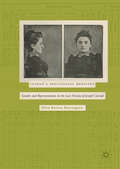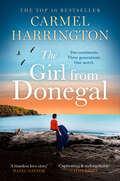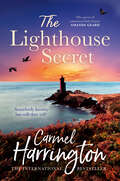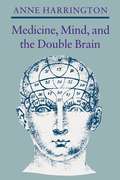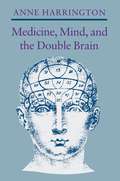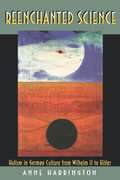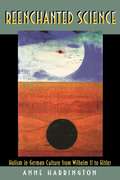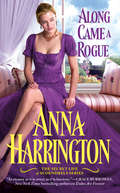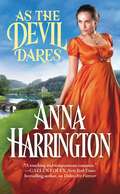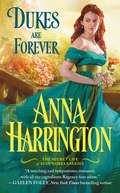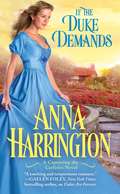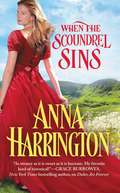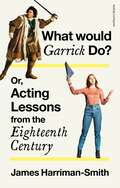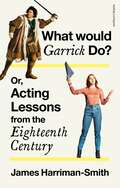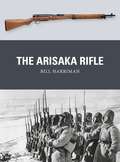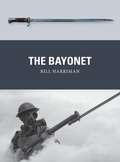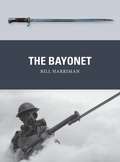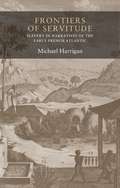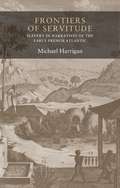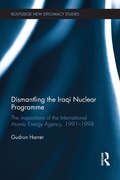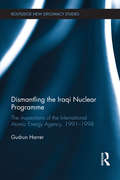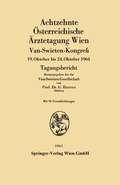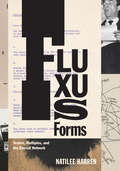- Table View
- List View
Conrad’s Sensational Heroines: Gender and Representation in the Late Fiction of Joseph Conrad
by Ellen Burton HarringtonThis volume considers Joseph Conrad’s use of multiple genres, including allusions to sensation fiction, pornography, anthropology, and Darwinian science, to respond to Victorian representations of gender in layered and contradictory representations of his own. In his stories and later novels, the familiar writer of sea stories centered on men moves to consider the plight of women and the challenges of renegotiating gender roles in the context of the early twentieth century. Conrad’s rich and conflicted consideration of subjectivity and alienation extends to some of his women characters, and his complex use of genre allows him both to prompt and to subvert readers’ expectations of popular forms, which typically offer recognizable formulas for gender roles. He frames his critique through familiar sensationalized typologies of women that are demonstrated in his fiction: the violent mother, the murderess, the female suicide, the fallen woman, the adulteress, and the traumatic victim. Considering these figures through the roles and the taxonomies that they simultaneously embody and disrupt, this study exposes internalized patriarchal expectations that Conrad presents as both illegitimate and inescapable.
The Girl from Donegal
by Carmel HarringtonI LOVED The Girl from Donegal. The storylines are so captivating and the sense of the secret that travels around the world is magical . . . unputdownable’ CATHY KELLY
Medicine, Mind, and the Double Brain: A Study in Nineteenth-Century Thought
by Anne HarringtonThe description for this book, Medicine, Mind, and the Double Brain: A Study in Nineteenth-Century Thought, will be forthcoming.
Medicine, Mind, and the Double Brain: A Study in Nineteenth-Century Thought
by Anne HarringtonThe description for this book, Medicine, Mind, and the Double Brain: A Study in Nineteenth-Century Thought, will be forthcoming.
Reenchanted Science: Holism in German Culture from Wilhelm II to Hitler
by Anne HarringtonBy the 1920s in Central Europe, it had become a truism among intellectuals that natural science had "disenchanted" the world, and in particular had reduced humans to mere mechanisms, devoid of higher purpose. But could a new science of "wholeness" heal what the old science of the "machine" had wrought? Some contemporary scientists thought it could. These years saw the spread of a new, "holistic" science designed to nourish the heart as well as the head, to "reenchant" even as it explained. Critics since have linked this holism to a German irrationalism that is supposed to have paved the way to Nazism. In a penetrating analysis of this science, Anne Harrington shows that in fact the story of holism in Germany is a politically heterogeneous story with multiple endings. Its alliances with Nazism were not inevitable, but resulted from reorganizational processes that ultimately brought commitments to wholeness and race, healing and death into a common framework. Before 1933, holistic science was a uniquely authoritative voice in cultural debates on the costs of modernization. It attracted not only scientists with Nazi sympathies but also moderates and leftists, some of whom left enduring humanistic legacies. Neither a "reduction" of science to its politics, nor a vision in which the sociocultural environment is a backdrop to the "internal" work of science, this story instead emphasizes how metaphor and imagery allow science to engage "real" phenomena of the laboratory in ways that are richly generative of human meanings and porous to the social and political imperatives of the hour.
Reenchanted Science: Holism in German Culture from Wilhelm II to Hitler
by Anne HarringtonBy the 1920s in Central Europe, it had become a truism among intellectuals that natural science had "disenchanted" the world, and in particular had reduced humans to mere mechanisms, devoid of higher purpose. But could a new science of "wholeness" heal what the old science of the "machine" had wrought? Some contemporary scientists thought it could. These years saw the spread of a new, "holistic" science designed to nourish the heart as well as the head, to "reenchant" even as it explained. Critics since have linked this holism to a German irrationalism that is supposed to have paved the way to Nazism. In a penetrating analysis of this science, Anne Harrington shows that in fact the story of holism in Germany is a politically heterogeneous story with multiple endings. Its alliances with Nazism were not inevitable, but resulted from reorganizational processes that ultimately brought commitments to wholeness and race, healing and death into a common framework. Before 1933, holistic science was a uniquely authoritative voice in cultural debates on the costs of modernization. It attracted not only scientists with Nazi sympathies but also moderates and leftists, some of whom left enduring humanistic legacies. Neither a "reduction" of science to its politics, nor a vision in which the sociocultural environment is a backdrop to the "internal" work of science, this story instead emphasizes how metaphor and imagery allow science to engage "real" phenomena of the laboratory in ways that are richly generative of human meanings and porous to the social and political imperatives of the hour.
Along Came a Rogue (The Secret Life of Scoundrels #2)
by Anna HarringtonTHE WICKEDEST SECRET . . . Major Nathaniel Grey is free to bed whomever he wants, whenever he chooses, and that's exactly how he likes it. His only loyalties are to country and the two friends he served with-brothers he'd do anything for. So when one of them is gravely injured and asking for his little sister, Grey will move heaven and earth to bring her home. He's greeted not by the gangly girl he remembers, but a stunningly beautiful woman holding a loaded musket. And he's utterly captivated by her . . . IS A SECRET SEDUCTION Once upon a time, Emily would have loved nothing more than a stolen hour with her brother's best friend, the dashing officer who captured her heart and soul. But things are different now--and so is she. Gone is the eager young woman who believed in love. In her place is a widow weighed down with secrets who desperately needs to disappear before they're revealed. But Grey's sinfully sexy smile offers protection unlike anything she's ever known, tempting her to risk everything . . . even her heart.
As the Devil Dares (Capturing the Carlisles #3)
by Anna HarringtonWhen playing a game of wits, never ever go up against the woman they call the Hellion . . . LOVE IS A BATTLEFIELD...Whether it's business or pleasure, Lord Robert Carlisle never backs down from a dare. But finding a husband for scandalous Mariah Winslow? It's one challenge he instantly regrets accepting. Even with all his connections---and rakish charms---Robert will have to use every trick in the book to marry off a woman with no dowry and no sense of decorum...no matter how stunningly beautiful she is.Mariah Winslow has no intention of being a pawn in Lord Robert's game. She knows he agreed to play matchmaker only to secure a partnership in her father's shipping company, a partnership that's rightfully hers. For now, though, she'll dress for the elegant balls he throws and dance with the eligible bachelors he chooses. But she won't be outwitted by the devil himself---no matter how tempting and irresistible she finds him."With its strong feminist bent and lively battle of wills, Harrington delivers what readers crave: a smart, fun read." -RT Book ReviewsCapturing the CarlislesIf the Duke DemandsWhen the Scoundrel SinsAs the Devil Dares
Dukes Are Forever (The Secret Life of Scoundrels #1)
by Anna HarringtonALL'S FAIR IN LOVEBattlefields and barrooms hold much more interest for Edward Westover, Duke of Strathmore, than a little girl's fondness for dolls and lace. When he takes possession of his enemy's estate, everything that villain held dear-including his daughter-belongs to Edward. Hire a governess, arrange a dowry, give a few reassurances, and be off on his way--that's Edward's plan. But he's in for the shock of his life. For his new ward is a beautiful, impetuous, and utterly irresistible woman . . . . . . AND WARKate Benton is stunned. Who is this arrogant, infuriating man who's invited himself into her home and taken over her life? Her vow: to do everything in her power to convince him to leave her-and Brambly House-alone. Yet as chilly days melt into sultry nights, Kate sees glimpses of kindness underneath Edward's cool façade . . . and a passionate nature that takes her breath away. There's so much she doesn't know about this man. But does she dare trust this devilish duke with her heart? The Secret Life of ScoundrelsDukes Are ForeverAlong Came a RogueHow I Married a Marquess
If the Duke Demands (Capturing The Carlisles Ser. #1)
by Anna HarringtonA LESSON IN SEDUCTION . . . Miranda Hodgkins has only ever wanted one thing: to marry Robert Carlisle. And she simply can't wait a moment longer. During the Carlisle family masquerade ball, Miranda boldly sneaks into his bedchamber with seduction on her mind. Soon she's swept into rock-hard arms for the most breathtaking kiss of her life. But when the masks come off, she's horrified to find herself face-to-face with Sebastian, the Duke of Trent-Robert's formidable older brother. Shocked to find Miranda in his bed, Sebastian quickly offers her a deal to avoid scandal: He'll help her win his brother's heart if she'll find him the perfect wife. But what begins as a simple negotiation soon spirals out of control. For the longer this reformed rake tries to make a match for Miranda, the more he wants to keep her all to himself. Capturing the Carlisles If the Duke Demands When the Scoundrel Sins As the Devil Dares
When the Scoundrel Sins (Capturing the Carlisles #2)
by Anna HarringtonA MOST INDECENT PROPOSALAnnabelle Green needs a husband-and quickly. To inherit the only home she's ever known, she must be married by her twenty-fifth birthday. But finding a suitor has been next to impossible after a reckless rogue named Quinton Carlisle seduced her into a scandalous midnight tryst. Her reputation in ruins, Belle now needs a rather large favor. And she knows just who to turn to . . . Quinn can hardly believe that the shy bookish girl he teased as a child has grown into such a brazen beauty. The very idea of marrying Belle to right the wrongs of his past is downright shocking . . . and deliciously tempting. Too bad marriage, convenient or otherwise, is the last thing Quinn wants. He'll help Belle find a husband and be on his way. But if he can't control his attraction to the bride-to-be, this marriage could go up in flames-of wicked desire. Capturing the CarlislesIf the Duke DemandsWhen the Scoundrel SinsAs the Devil Dares
What Would Garrick Do? Or, Acting Lessons from the Eighteenth Century
by James Harriman-SmithThe stage of the 1700s established a star culture, with the emergence of such acting celebrities as David Garrick, Susannah Cibber, and Sarah Siddons. It placed Shakespeare at the heart of the classical repertoire and offered unprecedented opportunities to female actors. This book demonstrates how an understanding of the practice and theories circulating three hundred years ago can generate new ways of studying and performing plays of all kinds in the present.Eight short essays – on emotions, cultivation, character, voice, action, company, audience, and reflection – provide two things: a vivid introduction to the practice and ideas of the eighteenth-century stage, and the story of how these past practices and ideas were used in collaborative workshops around the UK to create new rehearsal exercises. Designed to work alone or in combination, these exercises are also open to further adaptation and analysis as part of a work that treats theatre writers of the past as potential collaborators for those interested in theatre today. Marrying academic and professional theatre expertise, this book ranges through a vast archive of writing about acting, from private letters and battered promptbooks, through to philosophical treatises and celebrity biographies. The exercises, stories, and ideas shared here capture the strangeness of this material – and sometimes its surprising familiarity, as questions asked of actors then seem to anticipate those questions we ask now. A truly unique offering, What would Garrick Do? Or, Acting Lessons from the Eighteenth Century offers a fascinating deep-dive into an important time in theatre history to illuminate practices and processes today.
What Would Garrick Do? Or, Acting Lessons from the Eighteenth Century
by James Harriman-SmithThe stage of the 1700s established a star culture, with the emergence of such acting celebrities as David Garrick, Susannah Cibber, and Sarah Siddons. It placed Shakespeare at the heart of the classical repertoire and offered unprecedented opportunities to female actors. This book demonstrates how an understanding of the practice and theories circulating three hundred years ago can generate new ways of studying and performing plays of all kinds in the present.Eight short essays – on emotions, cultivation, character, voice, action, company, audience, and reflection – provide two things: a vivid introduction to the practice and ideas of the eighteenth-century stage, and the story of how these past practices and ideas were used in collaborative workshops around the UK to create new rehearsal exercises. Designed to work alone or in combination, these exercises are also open to further adaptation and analysis as part of a work that treats theatre writers of the past as potential collaborators for those interested in theatre today. Marrying academic and professional theatre expertise, this book ranges through a vast archive of writing about acting, from private letters and battered promptbooks, through to philosophical treatises and celebrity biographies. The exercises, stories, and ideas shared here capture the strangeness of this material – and sometimes its surprising familiarity, as questions asked of actors then seem to anticipate those questions we ask now. A truly unique offering, What would Garrick Do? Or, Acting Lessons from the Eighteenth Century offers a fascinating deep-dive into an important time in theatre history to illuminate practices and processes today.
The Arisaka Rifle (Weapon)
by Bill HarrimanEntering service in 1897, the Arisaka family of bolt-action rifles armed Japanese troops and others through two world wars and many other conflicts, including the Russo-Japanese War of 1904–05. Issued in long and short versions – the latter for cavalry and specialists – the Type 30 was the first main Arisaka model, arming Imperial Japan's forces during the Russo-Japanese War, though after the war it was refined into the Type 38, which would still be in use in 1945. The main Arisaka rifle of World War II though was the Type 99. Lighter and more rugged than the US M1903 Springfield rifle it would face in the initial battles in the Pacific, it was produced in four main variants, including a sniping model and a take-down parachutist's rifle. Featuring full-colour artwork as well as archive and close-up photographs, this is the absorbing story of the rifles arming Imperial Japan's forces, from the trenches of Mukden in 1905 to the beaches of Okinawa 40 years later.
The Arisaka Rifle (Weapon #70)
by Bill HarrimanEntering service in 1897, the Arisaka family of bolt-action rifles armed Japanese troops and others through two world wars and many other conflicts, including the Russo-Japanese War of 1904–05. Issued in long and short versions – the latter for cavalry and specialists – the Type 30 was the first main Arisaka model, arming Imperial Japan's forces during the Russo-Japanese War, though after the war it was refined into the Type 38, which would still be in use in 1945. The main Arisaka rifle of World War II though was the Type 99. Lighter and more rugged than the US M1903 Springfield rifle it would face in the initial battles in the Pacific, it was produced in four main variants, including a sniping model and a take-down parachutist's rifle. Featuring full-colour artwork as well as archive and close-up photographs, this is the absorbing story of the rifles arming Imperial Japan's forces, from the trenches of Mukden in 1905 to the beaches of Okinawa 40 years later.
The Bayonet (Weapon)
by Bill HarrimanAlthough muskets delivered devastating projectiles at comparatively long ranges, their slow rate of fire left the soldier very vulnerable while reloading, and early muskets were useless for close-quarter fighting. Consequently, European infantry regiments of the 17th century were composed of both musketeers and pikemen, who protected the musketeers while loading but also formed the shock component for close-quarter combat. The development of the flintlock musket produced a much less cumbersome and faster-firing firearm. When a short knife was stuck into its muzzle, every soldier could be armed with a missile weapon as well as one that could be used for close combat. The only disadvantage was that the musket could not be loaded or fired while the plug bayonet was in place. The socket bayonet solved this problem and the musket/bayonet combination became the universal infantry weapon from c.1700 to c.1870. The advent of shorter rifled firearms saw the attachment of short swords to rifle barrels. Their longer blades still gave the infantryman the 'reach' that contemporaries believed he needed to fend off cavalry attacks. The perfection of the small-bore magazine rifle in the 1890s saw the bayonet lose its tactical importance, becoming smaller and more knife-like, a trend that continued in the world wars. When assault rifles predominated from the 1950s onwards, the bayonet became a weapon of last resort. Its potential usefulness continued to be recognized, but its blade was often combined with an item with some additional function, most notably a wire-cutter. Ultimately, for all its fearsome reputation as a visceral, close-quarter fighting weapon, the bayonet's greatest impact was actually as a psychological weapon. Featuring full-colour artwork as well as archive and close-up photographs, this is the absorbing story of the complementary weapon to every soldier's firearm from the army of Louis XIV to modern-day forces in all global theatres of conflict.
The Bayonet (Weapon)
by Bill HarrimanAlthough muskets delivered devastating projectiles at comparatively long ranges, their slow rate of fire left the soldier very vulnerable while reloading, and early muskets were useless for close-quarter fighting. Consequently, European infantry regiments of the 17th century were composed of both musketeers and pikemen, who protected the musketeers while loading but also formed the shock component for close-quarter combat. The development of the flintlock musket produced a much less cumbersome and faster-firing firearm. When a short knife was stuck into its muzzle, every soldier could be armed with a missile weapon as well as one that could be used for close combat. The only disadvantage was that the musket could not be loaded or fired while the plug bayonet was in place. The socket bayonet solved this problem and the musket/bayonet combination became the universal infantry weapon from c.1700 to c.1870. The advent of shorter rifled firearms saw the attachment of short swords to rifle barrels. Their longer blades still gave the infantryman the 'reach' that contemporaries believed he needed to fend off cavalry attacks. The perfection of the small-bore magazine rifle in the 1890s saw the bayonet lose its tactical importance, becoming smaller and more knife-like, a trend that continued in the world wars. When assault rifles predominated from the 1950s onwards, the bayonet became a weapon of last resort. Its potential usefulness continued to be recognized, but its blade was often combined with an item with some additional function, most notably a wire-cutter. Ultimately, for all its fearsome reputation as a visceral, close-quarter fighting weapon, the bayonet's greatest impact was actually as a psychological weapon. Featuring full-colour artwork as well as archive and close-up photographs, this is the absorbing story of the complementary weapon to every soldier's firearm from the army of Louis XIV to modern-day forces in all global theatres of conflict.
Frontiers of servitude: Slavery in narratives of the early French Atlantic (Seventeenth And Eighteenth Century Studies)
by Michael HarriganBased on little-examined printed and archival sources, this book explores the fundamental ideas behind early French thinking about Atlantic slavery, c. 1620-1750. It analyses the three central questions of what made one a slave, of what was unique about Caribbean labour, and the implications of strategic approaches in interacting with slaves.
Frontiers of servitude: Slavery in narratives of the early French Atlantic (Seventeenth- and Eighteenth-Century Studies)
by Michael HarriganFrontiers of servitude explores the fundamental ideas behind early French thinking about Atlantic slavery in little-examined printed and archival sources, focusing on what 'made' a slave, what was unique about Caribbean labour, and what strategic approaches meant in interacting with slaves. From c. 1620 –1750, authoritative discourses were confronted with new social realities, and servitude was accompanied by continuing moral uncertainties. Slavery gave the ownership of labour and even time, but slaves were a troubling presence. Colonists were wary of what slaves knew, and were aware of how imperfect the strategies used to control them were. Commentators were conscious of the fragility of colonial society, with its social and ecological frontiers, its renegade slaves, and its population born to free fathers and slave mothers. This book will interest specialists and more general readers interested in the history and literature of the Atlantic and Caribbean.
Dismantling the Iraqi Nuclear Programme: The Inspections of the International Atomic Energy Agency, 1991–1998 (Routledge New Diplomacy Studies)
by Gudrun HarrerThis book is an authoritative account of the nuclear weapons inspections regime in Iraq from 1991 to 1998. Without a proper understanding of those years, the 2003 US invasion of Iraq after a futile WMD search remain unintelligible. In the 1990s, after adapting to a completely new kind of intrusive inspections with unprecedented access rights, the IAEA discovered and dismantled Iraq’s clandestine nuclear weapons program and put in place an efficient monitoring system which could have contained Saddam Hussein’s attempts to reconstitute his nuclear programs – had he ever tried to. However, the politicisation of the inspection process led to an end of the inspections in 1998. Based on various sources including inspection reports and other documents in the archive of the IAEA Iraq Action Team at the IAEA headquarters in Vienna, Dismantling the Iraqi Nuclear Programme presents completely new information about the weapons inspection regime in Iraq and offers valuable lessons for future non-proliferation and disarmament cases. The book also draws on discourse from Iraqi scientists, which provides a close look into not only the motivation of involved Iraqis, but also Iraqi concealment mechanisms. This book will be of much interest to students of nuclear proliferation, arms control, Middle Eastern politics, diplomacy, international security and IR.
Dismantling the Iraqi Nuclear Programme: The Inspections of the International Atomic Energy Agency, 1991–1998 (Routledge New Diplomacy Studies)
by Gudrun HarrerThis book is an authoritative account of the nuclear weapons inspections regime in Iraq from 1991 to 1998. Without a proper understanding of those years, the 2003 US invasion of Iraq after a futile WMD search remain unintelligible. In the 1990s, after adapting to a completely new kind of intrusive inspections with unprecedented access rights, the IAEA discovered and dismantled Iraq’s clandestine nuclear weapons program and put in place an efficient monitoring system which could have contained Saddam Hussein’s attempts to reconstitute his nuclear programs – had he ever tried to. However, the politicisation of the inspection process led to an end of the inspections in 1998. Based on various sources including inspection reports and other documents in the archive of the IAEA Iraq Action Team at the IAEA headquarters in Vienna, Dismantling the Iraqi Nuclear Programme presents completely new information about the weapons inspection regime in Iraq and offers valuable lessons for future non-proliferation and disarmament cases. The book also draws on discourse from Iraqi scientists, which provides a close look into not only the motivation of involved Iraqis, but also Iraqi concealment mechanisms. This book will be of much interest to students of nuclear proliferation, arms control, Middle Eastern politics, diplomacy, international security and IR.
Achtzehnte Österreichische Ärztetagung Wien: Van-Swieten-Kongreß: 19. Oktober bis 24. Oktober 1964 (Österreichische Ärztetagung #18)
by Gerhart HarrerFluxus Forms: Scores, Multiples, and the Eternal Network
by Natilee Harren“PURGE the world of dead art, imitation, artificial art. . . . Promote living art, anti-art, promote NON ART REALITY to be grasped by all peoples,” writes artist George Maciunas in his Fluxus manifesto of 1963. Reacting against an elitist art world enthralled by modernist aesthetics, Fluxus encouraged playfulness, chance, irreverence, and viewer participation. The diverse collective—including George Brecht, Robert Filliou, Dick Higgins, Alison Knowles, George Maciunas, Yoko Ono, Nam June Paik, Benjamin Patterson, Takako Saito, Mieko Shiomi, Ben Vautier, and Robert Watts—embraced humble objects and everyday gestures as critical means of finding freedom and excitement beyond traditional forms of art-making. While today the Fluxus collective is recognized for its radical neo-avant-garde works of performance, publishing, and relational art and its experimental, interdisciplinary approach, it was not taken seriously in its own time. With Fluxus Forms, Natilee Harren captures the magnetic energy of Fluxus activities and collaborations that emerged at the intersections of art, music, performance, and literature. The book offers insight into the nature of art in the 1960s as it traces the international development of the collective’s unique intermedia works—including event scores and Fluxbox multiples—that irreversibly expanded the boundaries of contemporary art.
Fluxus Forms: Scores, Multiples, and the Eternal Network
by Natilee Harren“PURGE the world of dead art, imitation, artificial art. . . . Promote living art, anti-art, promote NON ART REALITY to be grasped by all peoples,” writes artist George Maciunas in his Fluxus manifesto of 1963. Reacting against an elitist art world enthralled by modernist aesthetics, Fluxus encouraged playfulness, chance, irreverence, and viewer participation. The diverse collective—including George Brecht, Robert Filliou, Dick Higgins, Alison Knowles, George Maciunas, Yoko Ono, Nam June Paik, Benjamin Patterson, Takako Saito, Mieko Shiomi, Ben Vautier, and Robert Watts—embraced humble objects and everyday gestures as critical means of finding freedom and excitement beyond traditional forms of art-making. While today the Fluxus collective is recognized for its radical neo-avant-garde works of performance, publishing, and relational art and its experimental, interdisciplinary approach, it was not taken seriously in its own time. With Fluxus Forms, Natilee Harren captures the magnetic energy of Fluxus activities and collaborations that emerged at the intersections of art, music, performance, and literature. The book offers insight into the nature of art in the 1960s as it traces the international development of the collective’s unique intermedia works—including event scores and Fluxbox multiples—that irreversibly expanded the boundaries of contemporary art.
